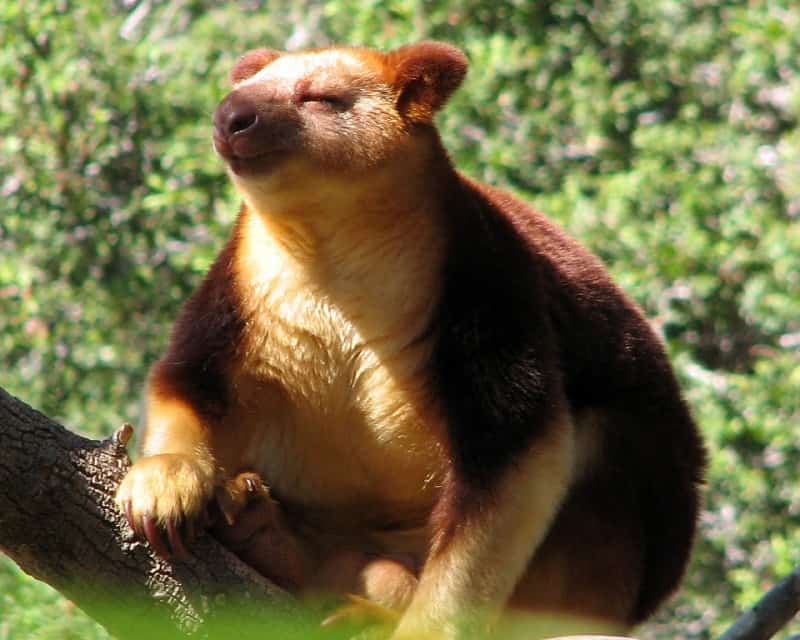Tree Kangaroo Facts
- The term Tree Kangaroo serves as the collective common name for about 12 separate species in the genus Dendrolagus. The uncertainty about the number of member species arises from differences of opinion regarding classification among scientists.
- All members of this amazing genus have one outstanding trait in common. The various species in the genus actually evolved as arboreal creatures. This group of remarkable animals also presently remains the only known arboreal macropods.
- Individuals of the various species all typically remain very slow and clumsy on the ground. The surprising mammal moves haltingly, and hops awkwardly. In the trees, though, it actually appears to be extremely agile and a very effective climber.
- This fantastic creature also ranks as a highly powerful leaper, much like its terrestrial cousins. It has been seen to jump as much as 30 ft (9 m) from one limb to another. It can also jump to the ground from as high as 59 ft (18 m) without incurring injury.
- Quite unfortunately, the IUCN currently lists the majority of known members in this incredible genus as Threatened. This regrettable listing appears in its Red List of Threatened Species. Only a few varieties do not hold this sad status.
- The reasons for this lamentable status, though, vary. These do, however, include factors such as habitat loss and human hunting. But, the Tree Kangaroo also now faces the ever-increasing danger of climate change, much like other creatures.
Related Articles
Tree Kangaroo Physical Description
The Tree Kangaroo continues to amaze us. That’s partly because the animal evolved several adaptations useful for an arboreal life. For one thing, its back legs grow significantly broader and shorter than those of its terrestrial cousins. This provides it with better balance.
The incredible creature also has quite long, and extensively curved, nails on those rear legs. These serve a far more important purpose than mere aesthetics. In fact, the magnificent mammal routinely, and quite effectively, uses these for gripping and climbing.
But the differences between it and related species does not end there. The Tree Kangaroo also has a much broader and longer tail than a terrestrial kangaroo. This evolutionary divergence provides the animal with an enhanced balance while moving through the canopy.
Much like terrestrial kangaroos, it remains physically incapable of sweating, to cool its body. The mammal developed an alternate method of thermo-regulation. Instead of sweating, it licks its forearms and allows the moisture to evaporate, thereby cooling it.
- Kingdom: Animalia
- Phylum: Chordata
- Class: Mammalia
- Order: Diprotodontia
- Family: Macropodidae
- Genus: Dendrolagus
Tree Kangaroo Distribution, Habitat, and Ecology
Unfortunately, the only known forms of the surprising Tree Kangaroo inhabit a highly restricted and vulnerable region of the world. This unfortunately limited region consists primarily of the rainforest regions of New Guinea, parts of Queensland, Australia.
The majestic creature also appears on a few local islands, though. For the moment, experts remain undecided as to how this occurred. Within this varied range, the various species within the genus understandably have somewhat different habitat preferences.
As a general principle, the majority of the different species in the genus prefer to live in various montane areas. There nevertheless remain several varieties that typically prefer to dwell in lowland areas. These more commonly encounter humans than the others.
This animal has even more specific habitat requirements. That’s due to the fact that it thrives in treetops, instead of the ground like its genetic cousins. The reason it managed to adapt better to regions of high altitude than its terrestrial cousins remains a mystery.
Breeding during the monsoon season, Tree Kangaroo matings produce only one young per litter. Its main predator seems to be the amethystine python, which inhabits the same canopies. Being herbivorous in nature, its own diet consists principally of fruits and leaves.
Species Sharing Its Range
Check out our other articles on Northern Hairy Nosed Wombat, Yunnan Golden Monkey, Okapi, Incredible Sharks of the World, Christmas Cactus, Hammer Orchid, Kakapo, Green Iguana

